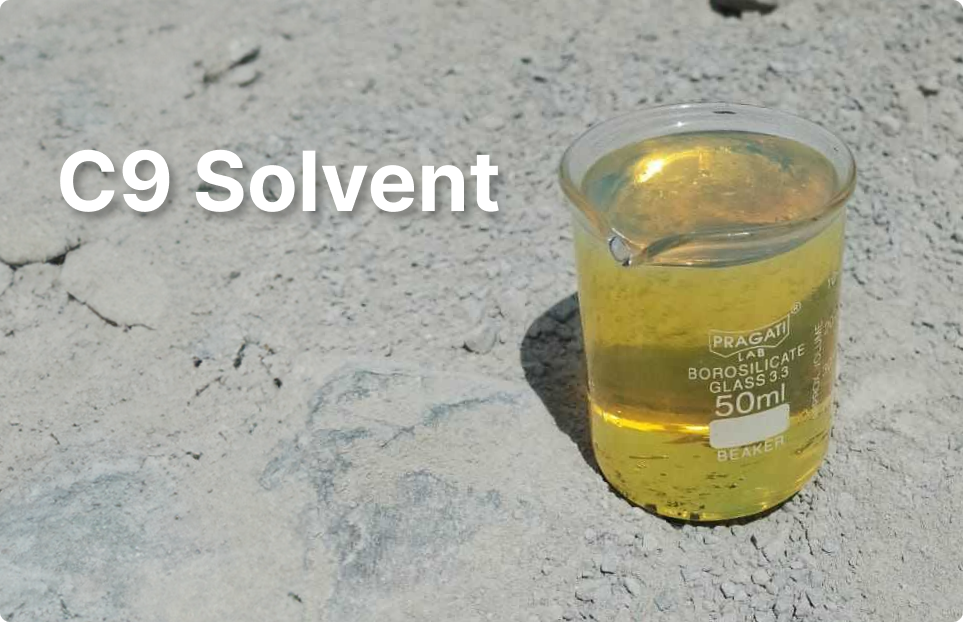
June 26, 2024
The Evolving Role of C9 Aromatic Solvent in Modern Industrial Applications
C9 aromatic solvent, often referred to simply as C9 solvent, might not be a household name, but its presence is felt across various industries. This colorless liquid with a distinct aromatic odor plays a crucial role in numerous processes, from cleaning and degreasing to paints and coatings. In this blog, we’ll delve into the evolving role of C9 solvent in modern industrial applications, exploring its properties, diverse uses, and the future trends shaping its landscape.
Properties and Characteristics
C9 solvent belongs to a group of hydrocarbons known as aromatic hydrocarbons, characterized by the presence of benzene rings in their molecular structure. Here’s a breakdown of its key properties:
Chemical Formula: Varies depending on the specific composition, but typically a mixture of hydrocarbons with 9 carbon atoms per molecule.
Appearance: Colorless liquid
Odor: Distinctive aromatic odor
Boiling Point: Approximately 150°C to 220°C (302°F to 428°F)
Solubility: Miscible with most organic solvents and some aliphatic hydrocarbons, but not readily soluble in water.
Volatility: Moderately volatile, meaning it can evaporate at room temperature.
These properties make C9 solvent a valuable solvent and cleaning agent, readily dissolving various materials like greases, oils, and resins.
C9 Solvent’s Industrial Footprint
C9 solvent boasts a long history of industrial applications, playing a vital role in:
Degreasing and Cleaning: C9 solvent’s ability to dissolve oils and greases effectively makes it ideal for cleaning metal parts, machinery, and surfaces in various industries like automotive, manufacturing, and metalworking. (Image of Industrial degreasing process)
Paints and Coatings: C9 solvent acts as a solvent for paint and coating components, facilitating their application and providing a smooth, even finish. Additionally, it can be used for cleaning paint brushes and equipment. (Image of Paint application process)
Printing Inks: Similar to paints, C9 solvent finds use in printing inks, ensuring proper viscosity and flow during printing processes. (Image of Industrial printing press)
Adhesives and Sealants: C9 solvent can be used in the production of adhesives and sealants, dissolving components and ensuring proper adhesion.
Agrochemicals: Some formulations of C9 solvent find application in the agricultural sector as carriers or diluents for pesticides and herbicides. C9 solvent might be used as a desiccant before harvest. C9 solvent may be used as a co-solvent in tank mixes with other agricultural chemicals, such as fertilizers and growth regulators. It helps dilute the active ingredients to the desired concentration for application and can aid in even distribution during spraying.
Foundry Industry: Foundries may use C9 solvent for cleaning and degreasing equipment, molds, and tools used in the casting process. C9 solvent can be used as a solvent for resins and binders used to create ceramic shell molds. These molds are used for casting metals with intricate details and smooth surface finishes.
These traditional applications showcase the versatility of C9 solvent as a reliable and effective industrial tool.
Emerging Applications: Pushing the Boundaries of C9 Solvent
Innovation is leading to exciting new applications for C9 solvent:
Pharmaceutical Manufacturing: C9 solvent’s ability to dissolve certain pharmaceutical ingredients makes it a potential candidate for use in the production of some medications.
Biodiesel Production: C9 solvent can be used as a co-solvent in biodiesel production, facilitating the separation of biodiesel from the reaction mixture. (Image of Biodiesel production plant)
Asphalt Industry: C9 solvent plays a role in asphalt production by aiding in the dilution of bitumen, a key component of asphalt.
Hot Road Markings: C9 Solvent is used as a petroleum resin in hot melt road marking paints to improve their performance and durability
These emerging applications demonstrate the ongoing exploration of C9 solvent’s potential beyond its traditional uses.
The Greener Side: Environmental Considerations and Regulations
The use of C9 solvent comes with environmental considerations. Its volatile nature can contribute to air pollution if not handled properly. Additionally, improper disposal can contaminate soil and water. As a result, regulations governing the use and disposal of C9 solvent are becoming increasingly stringent. Here’s a breakdown of the key factors:
Volatile Organic Compounds (VOCs): C9 solvent is classified as a VOC, meaning it can contribute to smog formation. Regulations like the EPA’s National Emission Standards for Hazardous Air Pollutants (NESHAP) may restrict its use in certain applications.
Environmental Regulations: Regulations like the Resource Conservation and Recovery Act (RCRA) may classify certain waste streams containing C9 solvent as hazardous waste, requiring proper disposal procedures.
Understanding and complying with environmental regulations is crucial for companies using C9 solvents.
The Future Outlook: Sustainability and Innovation
The future of C9 solvent appears to be driven by a focus on sustainability and innovation:
Bio-based C9 Solvents: Research and development are exploring the production of C9 solvents from renewable resources like biomass. This approach could offer a more environmentally friendly alternative to traditional petroleum-derived C9 solvent.
Lower VOC Formulations: Manufacturers are developing C9 solvent formulations with lower VOC content, reducing their environmental impact.
Safer Handling Practices: Emphasis on implementing safer handling practices and improved equipment for


